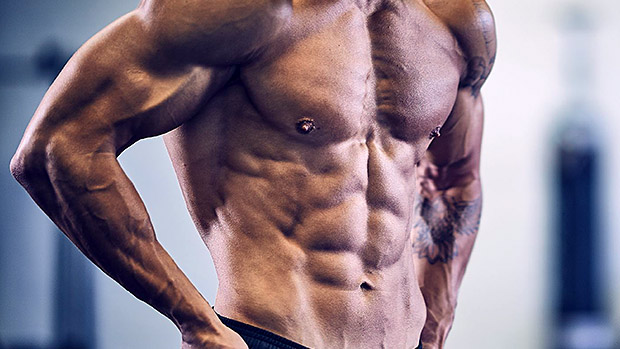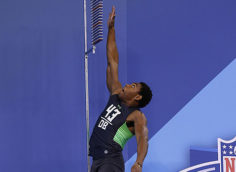The idea that bodyweight exercises can build muscle might seem foreign to some people. After all, most people's concept of bodyweight exercises are the stuff you see on cheesy workout DVDs.
The truth is, bodyweight exercises can be extremely effective for building muscle, when done correctly. Muscles respond to force. When you lift weights, your body generates force to fight against resistance and create tension. That's how the process of hypertrophy (muscle growth) begins.
But what if you don't have access to weights? Can you still create enough resistance and tension to build muscle? Absolutely. Here are some key bodyweight exercises you can do anywhere, anytime to help you build muscle. Then we'll dig into the science.
Push-ups are the bodyweight king when it comes to building a bigger chest and arms. Here are a few challenging variations:
Full Stop Push-Up
- Get into a push-up position, bring your chest down onto the floor and come to a full stop.
- While keeping your core engaged and your back straight, push yourself up from the floor to full extension.
Full stop push-ups eliminate any potential momentum or cheating during the exercise, putting sole emphasis on your chest to push yourself up from the floor.
Isometric Push-Up
These minimize momentum and add a pause.
- Bring your chest down toward the floor and come to a full stop two inches above the ground.
- While keeping your core engaged and your back straight, push yourself up from the floor to full extension.
Eccentric Push-Up
- Slowly lower yourself to the bottom position and hold for about 5 seconds.
- Explode back up to full extension.
You're going to be feeling the time under tension while you lower yourself and then apply as much force during the concentric phase. Maintain proper form.
Tiger Push-Up
This is an amazing variation for the triceps. It's almost like the Russian dip exercise, but on the floor.
- Set up in a push-up position with your hands about shoulder width apart.
- From there, shift your bodyweight back and come down to your elbows. You should be on your forearms with your hips raised up slightly higher than your starting position.
- Shift your weight forward onto your hands and push yourself up to full extension.
Repeat for 10 reps and tell me how your triceps feel.
Joe D. Pec Poppin' Push-Up
I'm borrowing this from Joe DeFranco because it's a good one.
- When you're in the starting position, think of pulling yourself to the floor by pushing your hands down and back into the floor. This helps you control the eccentric/negative phase and keep your shoulders set in place.
- When you get to the bottom of the push-up, press back up and hold.
- When your arms are fully extended, try to squeeze your hands together as hard as you can without moving them. Maintain this hard contraction for about 3 seconds.
You won't need to do these for more than 10 reps if you're doing them right.
Isometric Y-W-T
- Lay on your stomach and extend your arms out into a Y formation with your thumbs turned up to the ceiling, squeezing your shoulder blades together as hard as you can for about 3-5 seconds.
- Pull your elbows back down towards your ribs so your arms are in a W formation and hold again for 3 seconds, squeezing as hard as you can.
- Finally, extend your arms out into a T position with your thumbs still pointed to the ceiling and squeeze as hard as you can for 3 seconds. That's one rep. Do 6-8 of those and you won't need any more.
Another way to do this exercise would be to hold each position on its own for 30-40 seconds and rest for about 20-30 seconds before going again.
No matter which way you do it, the idea is to contract your upper back muscles and squeeze your shoulder blades together as hard as you can to create an isometric contraction.
Handcuffs
This is the best bang for your buck when it comes to bodyweight exercises for the shoulders and upper back. It can also be a great warm-up for the shoulders while stretching the pecs. It also fires up the small upper back muscles we tend to neglect during heavy rowing exercises.
There's no way you can cheat this move or use momentum to your advantage, something that you often see when people do weighted back exercises like rows and pulldowns.
- Start in a prone position by laying on your stomach with your hands behind your lower back (like you're being handcuffed).
- Extend your arms out straight by hinging at the elbow and begin to bring your arms to a Y position. Keep them locked and keep your thumbs turned up toward the ceiling.
- From there, do the same motion coming back, trying to make as big of a circle as you can coming around, and return to your starting position with your hands placed behind your lower back.
- You're then going to retract your shoulder blades. While keeping your hands on your lower back, bring your shoulder blades back down, and repeat this entire motion for 10-15 reps.
You might think there's no way to really train lower body without equipment. These moves might change your mind.
Isometric Squat
- Stand with your feet roughly shoulder-width apart, angled out slightly.
- Push your hips back and lower yourself into a full squat position with your legs at 90 degrees or lower.
- Hold the bottom position for 3-5 seconds and create as much tension as you can in the quads, glutes, and hamstrings.
- Stand and finish by pushing your hips through to full extension.
Eccentric Squat
- Stand with your feet about shoulder-width apart, angled out a little.
- Push your hips back and lower yourself into a full squat position, taking your sweet-ass time getting down there. Every inch counts, so maintain a slow and controlled tempo as you lower yourself to the bottom of the squat.
- Once you hit full depth (90 degrees or lower), stand back up to full extension and repeat.
Two Lunge Variations
Walking lunges are tough on their own, but these two modifications will make them even more effective. With the partial walking lunge, remember that muscles grow because of tension and resistance, so by adding a half rep to each stride you keep more uninterrupted tension on your quads, glutes, and hams, which means they'll grow bigger as a result.
The low-ceiling lunges are similar to partial lunges in that they cause constant tension in all of the supportive leg muscles.
Partial Walking Lunges
- Take a step forward, dropping your back knee toward the floor.
- Come up half way in your lunge stance, before dropping your back knee down again.
- Lunge forward with the other leg and repeat.
Do 12-15 of those while focusing on controlling the movement and your legs will blow up.
Low Ceiling Lunges
- Step forward in a lunge, staying low constantly as if you're in a room with a very low ceiling.
- As you transition between legs, instead of rising up to standing, you're going to stay as low as you can. This completely eliminates any break or mercy for your quads.
Isometrics
There are two types of isometric training – yielding and overcoming. Yielding is when you pause during an exercise and hold the weight (or your own bodyweight), producing an isometric contraction in your muscles.
Overcoming isometrics are when you're trying to move an immoveable object. This stimulates a maximal amount of muscle fibers and is particularly beneficial for powerlifters and other strength athletes looking to make gains in the main lifts. For the purposes of building muscle with bodyweight exercises, we're focusing on yielding isometric exercises.
Eccentrics
All of your favorite exercises have a concentric and eccentric phase to them. Think of a bench press. Do you ever notice it's a lot easier to bring the bar down to your chest than it is to push it back up? That's because we're about 20% stronger during the eccentric phase of most exercises.
That means we're able to control the eccentric portion of exercises more efficiently and create more time under tension. This is extremely beneficial for bodyweight lifts because we're forcing our muscles to work harder for a longer period of time, which translates to muscle hypertrophy.
Unilateral Exercises
Unilateral exercises are one-sided movements like lunges and step-ups.
The major benefit of incorporating these exercises from a muscle-building standpoint is they require more muscle recruitment to perform than most bilateral (two-sided) exercises. For example, when you perform a lunge, your core and stabilizer muscles are working hard to balance your body throughout the movement.
One and a Half or Partials
You know how brutal these can be if you tried them with the walking lunges above.
If you want to build muscle with bodyweight movements it's all about creating tension. Doing one and a half reps and partial reps will do just that.
Remember, rather than doing one rep of an exercise, you'd do half the movement followed by a full rep. For example, dropping to the bottom of a squat, coming up to a half squat stance, dropping back down and then coming up to full extension. That's a full rep.
- Our muscles grow due to the demand we put on them through tension and resistance.
- Isometric and eccentric exercises are a great way to create greater time under tension.
- Focus on optimal form and tempo for maximal muscle fiber recruitment.
- Leave your excuses at home if you travel frequently for work or don't have any equipment and use these bodyweight exercises to build muscle!





